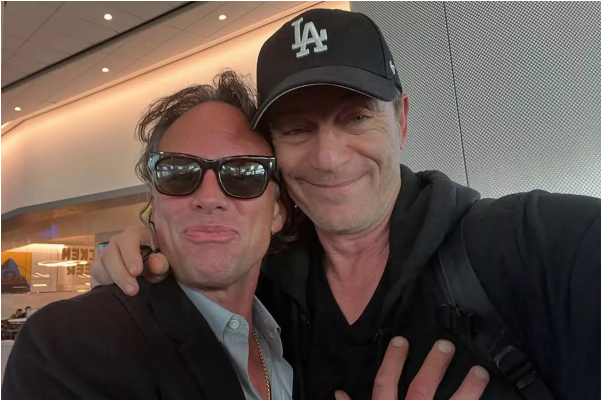TV
Behind the Smiles: White Lotus Stars Walton Goggins and Jason Isaacs Playfully Address Feud Whispers
1. Reunion Ignites Response to Online Speculation
In the aftermath of a highly anticipated season of HBO’s acclaimed anthology series The White Lotus, two of its notable cast members, Walton Goggins and Jason Isaacs, recently shared a reunion that quickly became a talking point, primarily for how they chose to address burgeoning online chatter. The two actors, who featured in the third installment of the hit show, were captured together in photographs posted on social media, purposefully engaging with rumors suggesting behind-the-scenes discord among the cast. Jason Isaacs took to Instagram to share images of himself alongside Walton Goggins during an encounter at an airport, pointedly making light of the “genius online sleuths” who had been busily hypothesizing about interpersonal tensions and drama occurring off-camera between the performers. This playful public display served as a direct, albeit humorous, response to the speculative narratives that had been circulating within fan communities and entertainment news circles following the conclusion of the season. The nature of their interaction, marked by apparent camaraderie and shared amusement, stood in contrast to the notions of conflict that had been brewing online.
The origins of these rumors can be traced back to earlier remarks made by Jason Isaacs himself, who had alluded to a challenging dynamic among the cast during interviews promoting the series. Isaacs had spoken candidly about the experience of filming in a somewhat isolated and intense environment for an extended period, mentioning that the production had been a “pressure cooker” and that friendships were both forged and potentially strained or “lost” over the course of the demanding shoot. These comments, while perhaps intended to convey the immersive and sometimes difficult nature of on-location filming, were interpreted by some as indicating significant friction or disagreements among the actors. Further fueling the speculative fire was the observation by certain fans that Walton Goggins and his on-screen romantic interest, portrayed by actress Aimee Lou Wood, had seemingly unfollowed each other on Instagram after the season wrapped up. In the age of social media, such digital actions are often scrutinized and analyzed by dedicated fan bases, frequently leading to assumptions and elaborate theories about real-life relationships and interactions among celebrities. The combination of Isaacs’ remarks and the social media activity of other cast members provided fertile ground for the online community to cultivate narratives of on-set “beef” and falling outs, turning online platforms into virtual detective agencies attempting to uncover hidden drama.

2. Navigating the “Pressure Cooker” of Production
The production of a show like The White Lotus, particularly when filmed on location in an exotic setting over a significant duration, inherently creates a unique environment for the cast and crew. Living and working in close proximity, often far from their usual support systems, can intensify interactions and relationships, sometimes positively fostering strong bonds, and at other times potentially leading to increased friction or misunderstandings. Jason Isaacs’ description of the set as a “pressure cooker” accurately captures this dynamic. The demands of filming a complex dramatic series, coupled with the challenges of being in a remote location, can create an environment where personal and professional lives inevitably intertwine in potentially complicated ways. In such a setting, minor disagreements or personality clashes that might be fleeting in a different work environment could potentially be magnified. The intensity of portraying characters involved in intricate and often dramatic storylines can also have an impact on the actors, as they immerse themselves in their roles for extended periods. While professional actors are trained to separate their on-screen performances from their off-screen lives, the sustained nature of a long production in an intense setting can blur these lines and contribute to heightened emotions and dynamics among the cast.
Isaacs’ comments about friendships being “made and lost” should be viewed within this context. It’s not uncommon for relationships to shift and evolve over the course of a lengthy production, as people spend vast amounts of time together under demanding circumstances. Alliances can form based on shared experiences or creative partnerships, while pre-existing relationships might be tested by the pressures of the job or the unique social dynamics of the set. The “Lord of the Flies” comparison sometimes used in describing such environments, while perhaps hyperbolic, speaks to the intense and sometimes unpredictable social dynamics that can emerge when a group of individuals is isolated together for a prolonged period. Understanding this inherent aspect of on-location filming provides a more nuanced perspective on the potential for both deep connections and occasional tensions among the cast, moving beyond simplistic interpretations of “feuds” driven by personal animosity. It highlights the human element of filmmaking and the impact that the production environment itself can have on the individuals involved, regardless of any pre-existing relationships or lack thereof.
3. The Anatomy of Online Speculation and “Mock Feuds”
The swiftness and intensity with which online speculation about a potential feud among The White Lotus cast members took hold speak volumes about the nature of contemporary celebrity culture and the role of social media. In the digital age, fans have unprecedented access to the lives and interactions of public figures, primarily through platforms like Instagram, X (formerly Twitter), and TikTok. This access, while fostering a sense of connection, also enables and encourages a level of scrutiny that can easily spiral into unfounded rumors and elaborate conspiracy theories. “Online sleuths,” as Jason Isaacs wryly referred to them, dedicate time and energy to analyzing everything from social media likes and follows to subtle cues in interviews and photographs, attempting to piece together narratives about celebrities’ private lives and relationships. This phenomenon is particularly prevalent with highly popular shows featuring ensemble casts, where the dynamics among the actors off-screen become as compelling to some fans as the fictional storylines on-screen. The perceived authenticity of reality television and documentary-style content has perhaps also contributed to a culture where audiences feel entitled to decipher the “real” relationships and conflicts behind scripted entertainment.
The concept of “mock feuds” in Hollywood provides an interesting parallel and contrast to genuine on-set tensions or rumors. Mock feuds, such as the long-running playful rivalry between Matt Damon and Jimmy Kimmel, are orchestrated or mutually agreed-upon comedic bits that celebrities engage in for entertainment purposes. They rely on the audience being in on the joke and are often used as a form of self-promotion or to generate positive buzz through humorous interaction. While the White Lotus situation began with what appeared to be genuine speculation fueled by candid remarks and social media activity, the way Goggins and Isaacs chose to respond – with a shared photo and sarcastic caption – leans into the territory of a mock feud. They are acknowledging the rumors but doing so in a way that dismisses their seriousness and invites others to laugh along with them at the absurdity of the online speculation. This strategic use of humor can be an effective way for public figures to deflate rumors and regain control of the narrative, turning potential negative attention into a positive or at least amusing interaction with their audience. It highlights the performative aspect of celebrity in the digital age, where even responses to rumors can become a form of entertainment.
4. Individual Talents and Shared Experience
Walton Goggins and Jason Isaacs are both highly respected actors with extensive and varied careers, known for their ability to inhabit complex and often morally ambiguous characters. Goggins has garnered critical acclaim for his work in shows like Justified, The Shield, and The Righteous Gemstones, often portraying charismatic yet volatile individuals. His performances are frequently lauded for their depth, nuance, and distinct Southern charm. Jason Isaacs, perhaps most widely recognized for his role as Lucius Malfoy in the Harry Potter film series, has also built a substantial career with diverse roles in film and television, showcasing his versatility across genres. His ability to portray characters with a sense of authority and underlying intensity makes him a compelling presence on screen. While their individual career paths and acting styles may differ, their shared experience on The White Lotus Season 3 brought them together in a unique professional and social context.
In The White Lotus, Goggins and Isaacs portrayed characters involved in the intricate web of relationships and conflicts that define the show. The dynamic between their specific characters, like many in the series, was layered and contributed to the overall satirical exploration of wealth, privilege, and human behavior. The shared experience of bringing these characters to life under the challenging conditions of the shoot, regardless of any minor on-set stresses, likely created a bond rooted in their mutual professionalism and the shared journey of the production. Actors who go through intense filming experiences together often develop a unique camaraderie, having navigated the demands of the job and the intricacies of the set as a unit. Their reunion and playful response to the feud rumors can be seen as a testament to this shared experience, suggesting that any on-set “tensions” were likely temporary or manageable within the context of a demanding job, rather than indicative of deep-seated animosity. It reinforces the idea that while the on-screen drama is a performance, the relationships forged during the creative process, even with their ups and downs, can be genuine and lasting.
5. Beyond the Headlines: Deconstructing Celebrity Narratives
The episode involving Walton Goggins, Jason Isaacs, and the “feud” rumors serves as a micro example of a larger phenomenon in contemporary media: the constant construction and deconstruction of celebrity narratives. Fueled by a voracious public appetite for insights into the private lives of famous individuals and amplified by the pervasive nature of social media, speculation and rumor can quickly eclipse the reality of a situation. Actors, as public figures, are constantly under a microscope, with their actions, words, and even digital interactions being interpreted and reinterpreted by fans and the media. The ambiguity of online communication and the tendency for sensationalism in reporting can easily distort the truth, transforming off-the-cuff remarks or simple social media activity into dramatic storylines. The “feud” rumors surrounding The White Lotus cast highlight how quickly a narrative can be built from relatively thin evidence, driven by the desire for behind-the-scenes drama that mirrors the fictional conflicts audiences consume.
Walton Goggins and Jason Isaacs’ decision to respond to the rumors, particularly in a lighthearted and public manner, is a form of reclaiming the narrative. By directly, yet humorously, addressing the speculation, they are signaling to their audience that the online theories are unfounded and that their relationship is one of mutual respect and camaraderie. This approach allows them to engage with the public’s interest without validating the basis of the rumor itself. It also serves as a gentle pushback against the intensity of online scrutiny and the tendency to invent drama where none exists. In an era where celebrity news cycles are relentless and often feed on negativity, their choice to counter the rumors with a display of warmth and humor offers a refreshing alternative. It reminds us that while the fictional worlds created on screen are designed for dramatic effect, the real-life interactions and relationships among the talented individuals who bring those worlds to life are often more complex, nuanced, and, in this case, perhaps less dramatic than the online narratives might suggest. Their reunion and shared amusement serve as a valuable reminder to approach online speculation with a healthy dose of skepticism and to remember that the stories we construct about celebrities are often just that – constructions, not necessarily reflections of reality.
From: Doublejoydesigns
